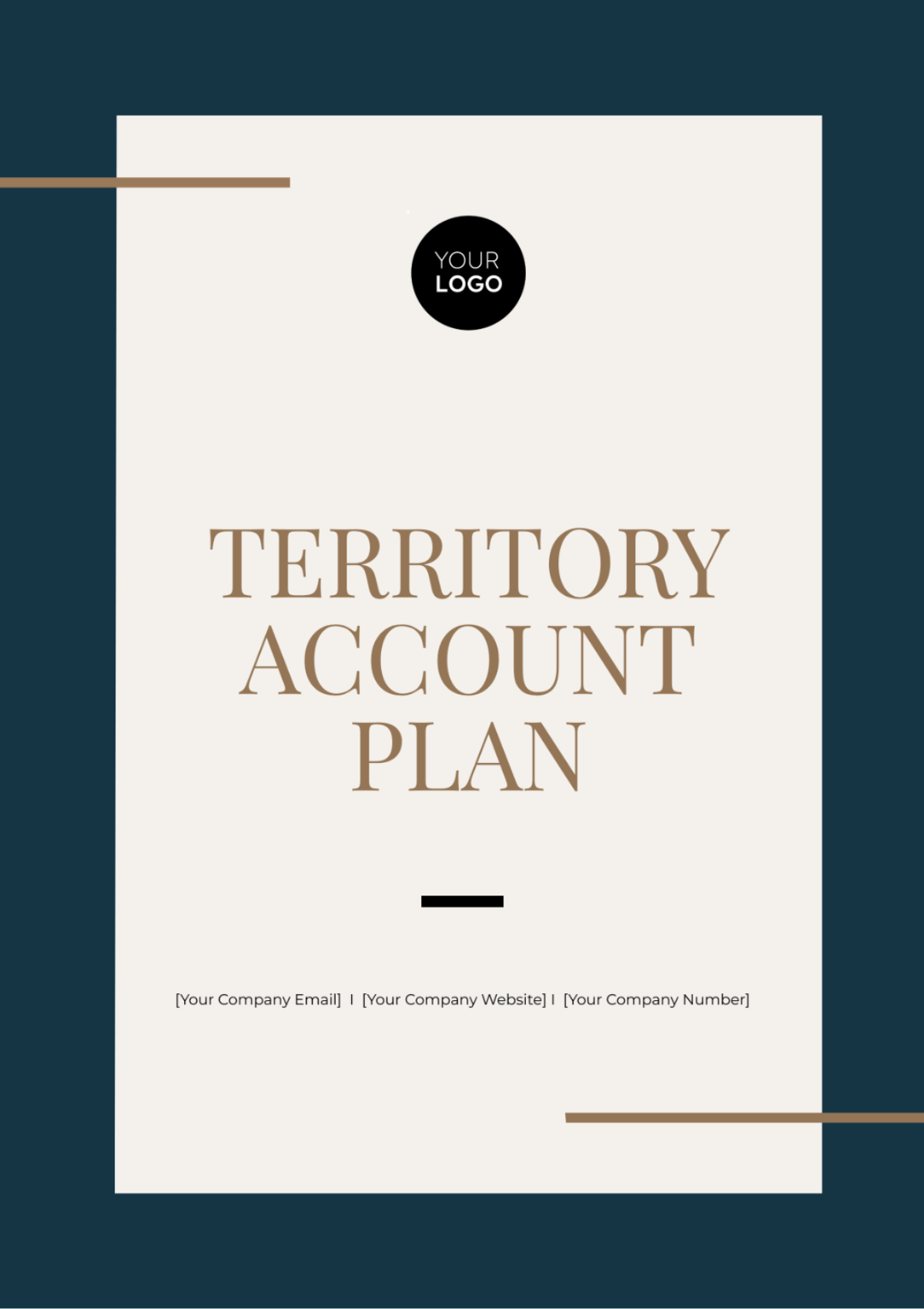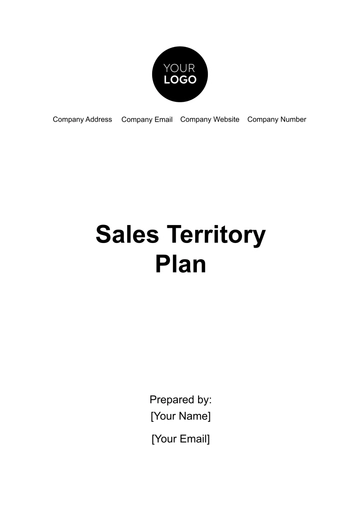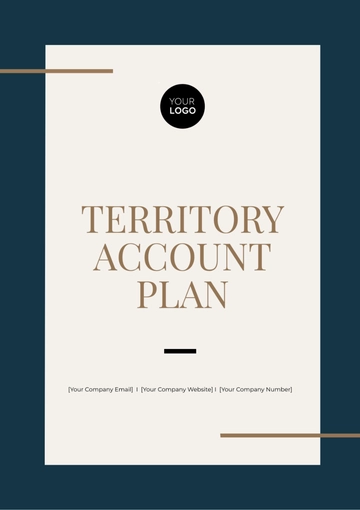Free Territory Account Plan

_____________________________________________________________________________________
I. Introduction
A Territory Account Plan emphasizes the importance of strategic planning in managing and growing sales within a specific territory. It highlights the significance of understanding the territory's market potential, customer segments, and competitive landscape. The introduction sets the stage for the detailed analysis and strategies outlined in the plan, emphasizing the goal of driving sustainable growth and achieving desired outcomes. It concludes by underscoring the structured approach outlined in the plan and expressing confidence in the team's ability to navigate the territory effectively.
II. Territory Overview
A. Geographic Scope
Territory Name: [Territory Name]
Geographical Boundaries: [Geographical Boundaries]
Major Cities and Regions Covered: [Regions Covered]
B. Market Analysis
Market Size
The market size for the Southwestern Region is estimated to be $50 billion annually.
Market Growth Rate
Projected annual growth rate of 10% over the next five years.
Target Customer Segments
Segment 1: Small to medium-sized businesses in the technology sector.
Segment 2: Healthcare institutions and providers.
Segment 3: Manufacturing companies specializing in aerospace and defense.
III. Objectives
The objective of this Territory Account Plan is to strategically penetrate and expand its presence within the designated geographic area or market segment. Through a comprehensive analysis of the territory's opportunities and challenges, this plan aims to:
Maximize Revenue Generation
Identify and capitalize on revenue opportunities within the territory by targeting key customer segments and optimizing sales strategies.
Increase Market Share
Enhance the market share within the territory through strategic positioning, competitive differentiation, and effective customer engagement.
Drive Customer Acquisition
Acquire new customers and expand customer base within the territory by implementing targeted sales campaigns and fostering meaningful relationships.
IV. Strategies
A. Customer Segmentation and Targeting
Identify key customer segments within the territory.
Develop tailored approaches for each segment to maximize relevance and effectiveness.
B. Relationship Building
Establish and nurture relationships with key stakeholders, including customers, partners, and influencers.
Leverage networking events, conferences, and industry associations to expand the network.
C. Sales Process Optimization
Streamline the sales process to improve efficiency and reduce lead times.
Implement CRM tools for better pipeline management and customer tracking.
D. Competitive Analysis
Identify competitors operating within the territory.
Analyze their strengths, weaknesses, and market positioning to develop competitive strategies.
Territory Account Plan:
V. Risk Management
A. Identified Risks
Economic Uncertainty
Fluctuations in the economy may impact customer spending behavior and purchasing power within the territory.
Competitive Pressure
Intense competition from existing competitors or new market entrants may pose a threat to market share and profitability.
Regulatory Changes
Changes in regulations or compliance requirements within the territory may necessitate adjustments to sales strategies and operations.
B. Risk Mitigation Strategies
Diversification
Expand customer base and product/service offerings to reduce reliance on a single market segment or revenue stream.
Competitive Analysis
Monitor competitor activities closely and adjust sales strategies accordingly to maintain a competitive edge.
Regulatory Compliance:
Stay informed about regulatory changes and ensure compliance through proactive measures and ongoing training.
VI. SWOT Analysis
A. Strengths
Established Brand Reputation: has a strong brand presence and reputation for delivering high-quality products/services.
Robust Sales Team: The sales team is highly skilled, motivated, and experienced in selling within the territory.
B. Weaknesses
Limited Market Awareness: There may lack of visibility or awareness in certain market segments or regions within the territory.
Resource Constraints: Limited budget or manpower may hinder the implementation of certain sales strategies or initiatives.
C. Opportunities
Emerging Market Trends: Can capitalize on emerging trends or market shifts within the territory to introduce new products/services or expand existing offerings.
Untapped Market Segments: Identify and target underserved or untapped market segments within the territory for growth opportunities.
D. Threats
Intense Competition: Competition from existing competitors or new market entrants may erode market share and pricing power within the territory.
Economic Volatility: Economic downturns or recessions may impact customer spending and purchasing behavior, leading to reduced sales volumes.
VII. Tactics
A. Account Prioritization
Prioritize accounts based on potential revenue, strategic importance, and readiness to buy.
B. Sales Campaigns
Launch targeted sales campaigns to penetrate key accounts and generate leads.
C. Promotional Activities
Plan and execute promotional activities such as discounts, promotions, and loyalty programs.
D. Sales Training and Enablement
Provide sales teams with the necessary training and resources to effectively sell within the territory.
VII. Measurement and Monitoring
A. Key Performance Indicators (KPIs)
Revenue Growth Rate
Market Share
Customer Acquisition Cost (CAC)
Customer Lifetime Value (CLV)
Sales Pipeline Velocity
B. Reporting Cadence
Weekly sales performance updates distributed to the sales team, highlighting key achievements, challenges, and action items.
Monthly comprehensive territory performance reports delivered to management, including detailed analysis of KPIs, market trends, and competitive landscape.
Quarterly business reviews conducted with cross-functional teams to assess overall territory health, identify opportunities for improvement, and adjust strategies as needed.
- 100% Customizable, free editor
- Access 1 Million+ Templates, photo’s & graphics
- Download or share as a template
- Click and replace photos, graphics, text, backgrounds
- Resize, crop, AI write & more
- Access advanced editor
Introducing the Territory Account Plan Template from Template.net – the ultimate solution for strategic sales planning. This editable and customizable template empowers you to craft tailored account strategies effortlessly. Seamlessly edit in our AI tool to align objectives, analyze market trends, and drive targeted growth. Streamline your approach today!
You may also like
- Finance Plan
- Construction Plan
- Sales Plan
- Development Plan
- Career Plan
- Budget Plan
- HR Plan
- Education Plan
- Transition Plan
- Work Plan
- Training Plan
- Communication Plan
- Operation Plan
- Health And Safety Plan
- Strategy Plan
- Professional Development Plan
- Advertising Plan
- Risk Management Plan
- Restaurant Plan
- School Plan
- Nursing Home Patient Care Plan
- Nursing Care Plan
- Plan Event
- Startup Plan
- Social Media Plan
- Staffing Plan
- Annual Plan
- Content Plan
- Payment Plan
- Implementation Plan
- Hotel Plan
- Workout Plan
- Accounting Plan
- Campaign Plan
- Essay Plan
- 30 60 90 Day Plan
- Research Plan
- Recruitment Plan
- 90 Day Plan
- Quarterly Plan
- Emergency Plan
- 5 Year Plan
- Gym Plan
- Personal Plan
- IT and Software Plan
- Treatment Plan
- Real Estate Plan
- Law Firm Plan
- Healthcare Plan
- Improvement Plan
- Media Plan
- 5 Year Business Plan
- Learning Plan
- Marketing Campaign Plan
- Travel Agency Plan
- Cleaning Services Plan
- Interior Design Plan
- Performance Plan
- PR Plan
- Birth Plan
- Life Plan
- SEO Plan
- Disaster Recovery Plan
- Continuity Plan
- Launch Plan
- Legal Plan
- Behavior Plan
- Performance Improvement Plan
- Salon Plan
- Security Plan
- Security Management Plan
- Employee Development Plan
- Quality Plan
- Service Improvement Plan
- Growth Plan
- Incident Response Plan
- Basketball Plan
- Emergency Action Plan
- Product Launch Plan
- Spa Plan
- Employee Training Plan
- Data Analysis Plan
- Employee Action Plan
- Territory Plan
- Audit Plan
- Classroom Plan
- Activity Plan
- Parenting Plan
- Care Plan
- Project Execution Plan
- Exercise Plan
- Internship Plan
- Software Development Plan
- Continuous Improvement Plan
- Leave Plan
- 90 Day Sales Plan
- Advertising Agency Plan
- Employee Transition Plan
- Smart Action Plan
- Workplace Safety Plan
- Behavior Change Plan
- Contingency Plan
- Continuity of Operations Plan
- Health Plan
- Quality Control Plan
- Self Plan
- Sports Development Plan
- Change Management Plan
- Ecommerce Plan
- Personal Financial Plan
- Process Improvement Plan
- 30-60-90 Day Sales Plan
- Crisis Management Plan
- Engagement Plan
- Execution Plan
- Pandemic Plan
- Quality Assurance Plan
- Service Continuity Plan
- Agile Project Plan
- Fundraising Plan
- Job Transition Plan
- Asset Maintenance Plan
- Maintenance Plan
- Software Test Plan
- Staff Training and Development Plan
- 3 Year Plan
- Brand Activation Plan
- Release Plan
- Resource Plan
- Risk Mitigation Plan
- Teacher Plan
- 30 60 90 Day Plan for New Manager
- Food Safety Plan
- Food Truck Plan
- Hiring Plan
- Quality Management Plan
- Wellness Plan
- Behavior Intervention Plan
- Bonus Plan
- Investment Plan
- Maternity Leave Plan
- Pandemic Response Plan
- Succession Planning
- Coaching Plan
- Configuration Management Plan
- Remote Work Plan
- Self Care Plan
- Teaching Plan
- 100-Day Plan
- HACCP Plan
- Student Plan
- Sustainability Plan
- 30 60 90 Day Plan for Interview
- Access Plan
- Site Specific Safety Plan

